Children's scooters: types, selection and operating rules
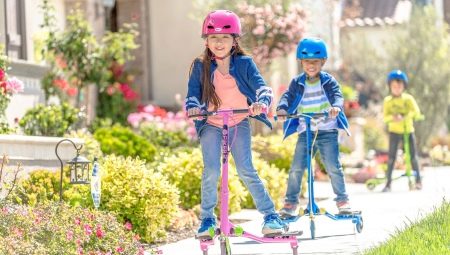
One of the safest and most fun means of transportation for children today is a scooter. It can be used by both teenagers for quick movement between school and home, and very young children who want to have fun and actively spend time. In this material, you will get acquainted with the main types of modern scooters, as well as the rules for their selection and operation.
Peculiarities
Modern children's scooters have long gone beyond the usual toy and have become a full-fledged means of transportation, which is actively used both for outdoor games and for moving over fairly long distances (to kindergarten or school).
If earlier scooters were just one frame, a handlebar and a platform with wheels, today the designs of some modern scooters are not inferior in complexity even to bicycles.
The popularity of children's scooters is explained by a number of advantages, which will be discussed below.


The benefits and harms of riding
Only certain models of children's scooters differ in serious pros and cons. As for the general features, then there are still much more positive aspects in the use of these means of transportation.
Pros.
- Stimulating the work of the body. For young children, a scooter is not only a toy, but also a full-fledged simulator, using which many muscle groups are trained, the cardiovascular and skeletal systems are strengthened.In addition, a high-quality scooter stimulates lung function, which makes it possible to prevent diseases associated with them.
- Developing mindfulness. Constantly riding the scooter forces your child to focus on the street obstacles, people or animals passing by. This has a positive effect on the condition of the eyes and reduces the level of distraction.
- Vestibular apparatus. A scooter, even if it is a children's model, requires balance from its owner. This stimulates and hardens the baby's body, makes him get used to the sense of balance and feel great even on a relatively narrow scooter deck.
- Security. The scooter is considered the safest means of transportation among bicycles or roller skates. The speed of scooters is extremely limited, they can only ride on steep hills on their own, and the child himself can jump off this vehicle at any time, thereby stopping its progress.
- Versatility. In terms of versatility, a scooter is slightly better than roller skates - it does not require an exceptionally flat road from a child to gain speed and overcome obstacles, which allows you to actively use this vehicle when going to school.
- Ease of use. A scooter, unlike a bicycle or skates, does not require any initial riding skills from a child. In addition, a large and long platform is not required for acceleration and use of the children's model.
- Ease of assembly. Modern children's scooters have a much more simplified assembly scheme than the same bicycles. This means that there are far fewer elements to break.


Today there is a myth that riding a scooter leads to the formation of scoliotic posture or scoliosis in young children. It was formed thanks to the assertion that all "one-sided" sports, in which the main load is on a certain limb, eventually bend the spine.
This myth can be refuted very simply - it is worth recalling the most common "one-sided" sports: fencing and tennis, in which the main load is on the serving arm and supporting leg.
Based on the logic of this myth, all people who practice these sports should have scoliosis. In reality, almost all of these athletes have excellent health, slender physique and do not suffer from scoliosis.


In fact, curvature of posture is caused not by "one-sided" sports, but by monotonous and uneven distribution of the load on the spine (sitting for a long time at lessons or carrying a heavy briefcase).
As for the formation of scoliosis, the likelihood of its formation from riding a scooter is minimal. To fully control the situation, experts advise parents to force their children from time to time to change the support and push leg on the scooter.
Low-quality and cheap models can be really harmful when riding a scooter. Most often this is an excessive percentage of plastic in the structure, poor-quality wheel material, poorly balanced steering wheel or a sliding deck. Such nuances can actually lead to sidewalk crashes and serious injury.
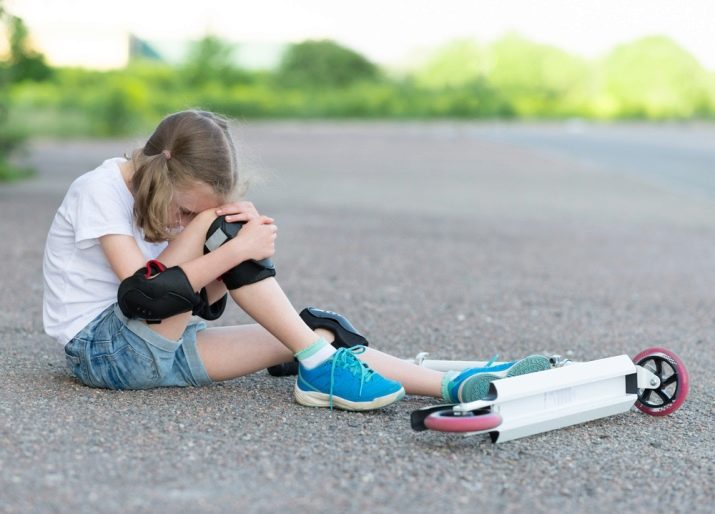
Design and device
Any scooter, regardless of its type and purpose, has a number of components that directly affect its speed, weight and maneuverability.
Frame
This is the key component of the scooter that connects the handlebar to the deck (pad to place the guide foot). It is on the frame that the most pressure is exerted during long trips or performing difficult stunts., and therefore in professional models, it is monolithic, and not folding.
Soundboard
This is the platform on which the child's supporting or guiding leg is placed. Supported by 2, 3 or 4 wheels. The main function of the deck is to maintain balance and keep the child on wheels. Decks can be metal (steel, aluminum) or plastic - the former are more durable, but heavy, the latter are lighter, but wear out quickly.

Steering wheel
It is connected to the frame and has the function of regulating the direction of the scooter and also helps to maintain balance. It usually consists of two rubberized rectangular or curved handles. It can be equipped with a brake system and a bell.
Wheels
Responsible for the speed, reliability and sensitivity of a particular scooter. So, scooters with rubber wheels pass problematic road sections with holes and bruises more easily... Plastic wheels will quickly wear off from such a ride, they do not absorb vibrations from stones and irregularities, which negatively affects the condition of the child's hands.
Brake
A scooter can have two brakes at once - rear and front. Their main function is to control the vehicle while gaining high speed on hills or uneven road sections. There are foot and hand brakes for children's scooters. The first ones are more suitable specifically for babies who still do not know how to quickly coordinate movements.

Folding mechanism
This element is not present in all modern children's scooters. It allows you to quickly fold the model, which can be very convenient when walking long distances on uneven terrain with a lot of slides. Besides, the folding mechanism simplifies transportation of the scooter, however, it directly affects its reliability and strength.
Depreciation
Models with high-quality shock absorbers are rarely found among children's bicycles. Usually, they are cushioned by rubber or rubberized wheels, which are able to dampen most of the vibration from driving on problem areas of the road.


Varieties
There are several classifications of children's bicycles, depending on the number of wheels, their diameter and width. It is the wheels that determine the speed, weight, maneuverability and safety of the scooter.
If we consider the classification of children's scooters by the number of wheels, then there are 2-, 3- and 4-wheel options.
- Two-wheeled they do not have good stability, but they are maneuverable and capable of developing significant speed on flat roads. Children's two-wheeled models are no different from adults, except for reduced dimensions. They can be used by children and adolescents from the age of 5.
- Tricycles - a common version of scooters for kids from 3 to 5 years old. Good stability, but poor cornering performance.
- Four-wheeled scooters or "mini" - this is the recommended type of scooters for very young children (from 1.5 years old). They are as safe as possible due to complete balance and stability.



If we consider the classification of children's and teenage scooters in relation to their purpose, then here they distinguish sports, inertial, "parent", urban models, as well as SUVs, electric scooters and ski models.
- Urban. Such models are distinguished by their compactness, simplified assembly, intuitive control and comfortable movement on flat sidewalks. Typically these models have soft and small rubber wheels that provide a smooth ride with comfortable cushioning.


- Sports or stunt... These models of high-speed scooters are designed exclusively for fast movement on flat roads and regular performance of stunts and jumps on special slides. They have narrow rubber wheels, which give the scooter excellent speed, but have poor shock absorption.


- Inertial. Most often these are three-wheeled scooter models that develop speed due to the mobility of the deck and the transfer of body weight by the child from one limb to another.These scooters do not require frequent push-off, but they are suitable for already grown-up children who are able to control balance and use their body weight.


- "Parental". The parent-type scooter models are designed for the youngest children and are more like a smaller version of a stroller than a regular scooter. Such models have two frames, where the child is responsible for controlling the front, and the rear is equipped with a special handle for parents. Often such models are called "transformer" - all additional components, including handles for parents, can be removed or disconnected as the child grows up. In addition, parental scooter models can be equipped with a music player and special stands for baby toys.


- SUVs. These models are usually equipped with large front wheels, almost like a bicycle. Due to such a diameter of the wheels, they are able to develop tremendous speed, have excellent maneuverability and perfectly cope with any condition of the road surface. In SUVs, an excellent shock absorber is often installed, rubber wheels are present, as well as rear and front brakes.


- Electric scooters... A great option for teenagers who have to go to school every day. On average, these scooters can travel at speeds of up to 30 km / h, and their charge is enough for no more than an hour of continuous driving.

- Ski scooters. An option for children who do not want to give up scooter riding even in winter. The model is equipped with ski sliding platforms instead of wheels, and the frame of the model itself is usually made of aluminum.
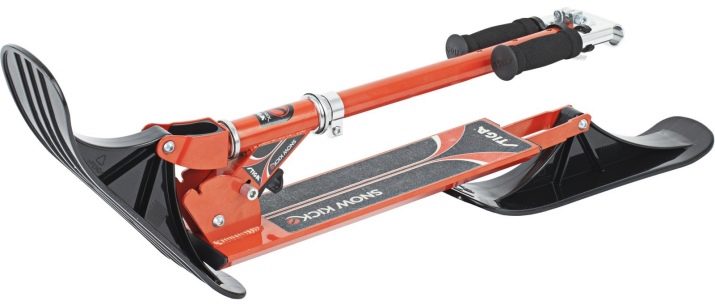
At what age can you ride?
Experts have not set strict age requirements for kids who can ride a scooter. Some parents put two-year-olds on a scooter to learn coordination and balance.
For better training of these qualities, 3-4-wheeled versions of scooters with a large deck are suitable. But older kids (from 5 to 9 years old) can already change to two-wheeled versions of scooters.
We take into account the growth
The main point that you should pay attention to when choosing a scooter model is the correspondence of the height of the steering wheel of the scooter to the level of the chest. Since in modern models the height of the steering wheel is most often regulated, check its maximum height - this will play into your hands when your child grows up.

Your scooter stand should look something like this:
- the supporting leg is on the deck, the second leg for pushing off is on the ground;
- the child's back is straight, he does not have to bend or stretch to grab the handlebars;
- the arms should be bent at the elbows at right angles while holding the steering wheel.
Also, pay attention to the length and width of the scooter deck. Models that are too long or wide have poor speed and maneuverability and are much more difficult to control. The deck must be low above ground level, otherwise your child will spend a tremendous amount of effort squatting to accelerate the bike.
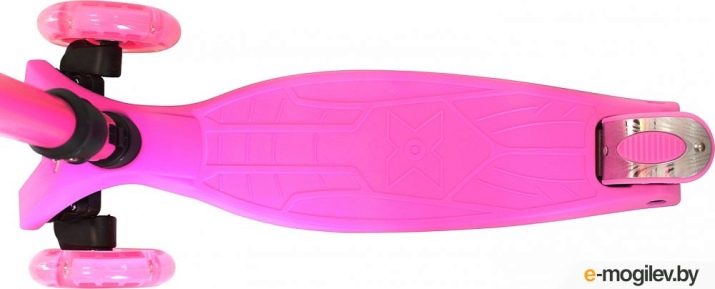
Rating of the best models
Below you can find an overview of the best children's scooters from foreign companies.
- Yedoo mau... This is an excellent two-wheeled scooter option for adult children who prefer active off-road riding. It can be made in 5 original colors, has a high-quality brake, comfortable and soft handles, a leg for a stand and can withstand a load of up to 75 kg. The only drawback is the large weight of 6.5 kg and the lack of a folding mechanism.


- Small Rider Dragon. A popular urban scooter model for children aged 3 years and older. It has a good hand brake, comfortable grips, a folding mechanism, as well as musical and even light accompaniment while driving. An obvious disadvantage is the need to constantly replace the batteries.

- Xiaomi Rice Rabbit Scooter. This three-wheeled scooter has not only a sophisticated design, but also a folding mechanism, a non-slip rubber deck, ride lights (wheels) and high-quality assembly materials. As a minus, only a harsh brake can be noted here.



- Three-wheeled trolley Capella Puppy. This model is considered one of the best for very young children. It is made in a pleasant and colorful design, has soft glowing wheels, a durable plastic frame and a non-slip deck. Additional accessories include a durable seat for the baby.

- Mini Micro 3 in 1. An extremely popular three-wheeled model for kids from 1.5 to 4 years old. It has a very light weight, is equipped with a retractable handlebar, a special handle for parents, as well as special supports for the baby's legs. Able to support up to 20 kg of weight. Wheels - high quality polyurethane.


How to choose?
It would be most reasonable to choose a scooter model not through an Internet service, but in an offline store, where your child can get acquainted with all the pros and cons of a scooter live and determine for himself whether it suits him or not.
Besides, When choosing a kids scooter, pay attention to the following factors.
Dimensions and weight
- The best scooter option for your child is one with the handlebars reaching their chest. Considering that children grow and stretch very quickly, choose models with adjustable frame and handlebar lengths.
- The length of the deck determines whether it will be convenient for your child to place his foot on it. In children's models, the average length of the deck does not exceed 40 cm, and the width rarely exceeds 20 cm.
Keep in mind that the longer and wider the deck, the easier it will be for the child to maintain balance on the bike and the heavier and more clumsy the scooter itself will be.
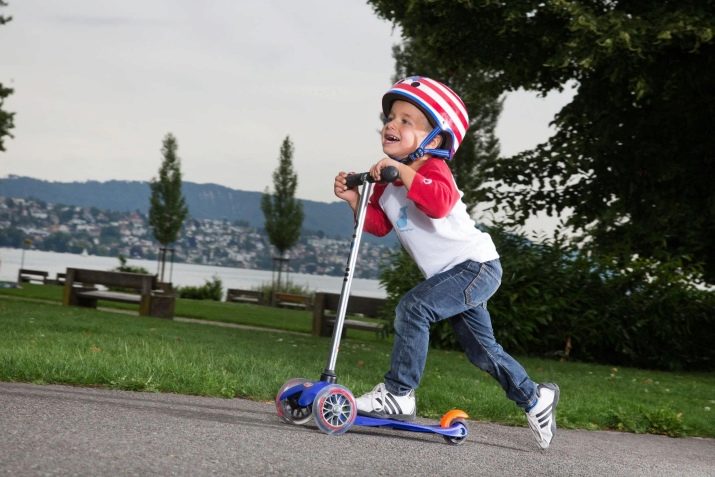
Wheels
Most often in the manufacture of scooter wheels 3 materials are used - polyurethane, rubber and plastic.
- Polyurethane considered to be more durable and reliable, with such wheels the scooter can last up to several years. When choosing a scooter with such wheels, specify their diameter - it can be from 13 to 20 cm. It is believed that the higher this indicator, the faster the model can accelerate. You should also evaluate the rigidity of such wheels - it usually varies from 72 to 93A. Soft models may be more comfortable for children, however, when driving on uneven and rocky roads, such wheels will quickly wear off and will bounce on any unevenness.
- Plastic most often found in cheap models of children's scooters with the simplest design. It wears out quickly, develops poor speed and reacts harshly on a bad road.
- Rubber - a universal option for wheels in a scooter. These models are inexpensive, last long and provide high-quality shock absorption on uneven surfaces.

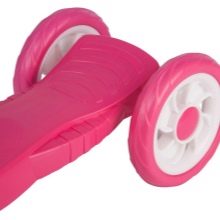

Brake elements
For very young children, experts advise buying scooter models with a hand brake - this type provides quick but smooth braking and exerts minimal stress on the wheels of the scooter. For older children, the foot brake will be more convenient - it allows you to brake sharply in a dangerous situation.
Frame components
In any scooter, be it for children, adults or professional models, the main load during the trip goes to the frame. If you are buying a scooter for a small child, then sturdy plastic frame models are also suitable., however, if your child is over 6 years old (or is already a teenager +11 years old), you should opt for scooter models with metal frame components. They will be heavier, but they will last longer.
Today, there are often models of children's scooters with folding frames, but this function is not available in stunt and adult models. The folding frame is unable to withstand heavy loads for a long time, which leads to breakage of the connecting elements.

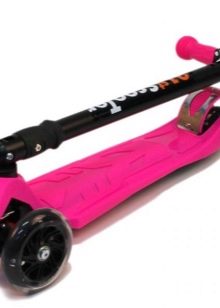
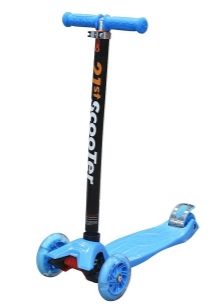
Steering wheel
It is better to choose models with an adjustable steering wheel and a reliable locking lock. The handlebars, which in the future will be responsible for the maneuverability of the scooter, should be pleasant to the touch and not slip in the baby's hands.
Design
Today, almost all models of children's scooters have a variegated and bright color, designed to turn the process of riding from a monotonous ride into a pleasant entertainment. If we talk about the color of scooters for boys and girls, then today you can find models in completely different colors: from standard blue and pink to burgundy, green and purple shades.






How to assemble and disassemble a scooter?
Most modern scooters have a simplified and intuitive assembly scheme, which makes them easy to assemble, disassemble or repair yourself. Moreover, the instructions for each new model should contain a detailed assembly diagram of your particular scooter.
In general, the instructions for assembling a regular children's scooter model will look like this.
- First, the wheels of the scooter are attached to its deck.
- Then the steering collar should be installed, as well as the steering wheel of the model itself.
- After completing each stage of fastening the elements, check the strength of the fasteners, clamps and clamp.
- Referring to the instructions, attach the brakes. Then it is worth connecting the deck (already with the wheels) to the steering wheel.
- The last procedure is to inflate the wheels. You should also check if the brake is working properly. The pads should be located exactly in the center of the rim, the tension of the brake cables is adjusted with bolts or keys.


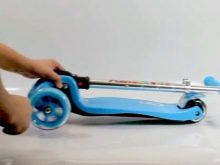
How to teach a child to ride?
It depends on the parents how quickly their child learns to ride a scooter. To make the training as painless and effective as possible, adhere to the following driving rules.
- Before starting the learning process, explain to your child that the main thing in this matter is to try to maintain balance and not be afraid to use the jogging leg to maintain it.
- Initial stance - the child stands with one foot on the deck, the other rests on the ground to push. Both hands firmly grip the steering wheel.
- The child starts by pushing off the ground or the surface of the room with his free leg.
- To adjust the direction of the scooter, smoothly turn its steering wheel and shift the body weight in the desired direction. Explain to your child that the higher the speed of the scooter, the smoother the turn should be.
- To brake, the child must first apply the rear and then the front brake.
It is desirable that the braking is smooth. The training should be carried out on a level and dry surface, where there is no possibility of sliding or collisions with foreign objects.

The first training sessions should not be carried out on hills and areas with steep hills. - there is too great a chance to get injured. If the training takes place outdoors or indoors with a hard floor, take care of purchasing special outfits for your child (helmet, elbow pads and knee pads).
To make the model "obey" the child as accurately as possible and serve for a long time, constantly check the integrity of the mountings.
How to choose a children's scooter, see below.








